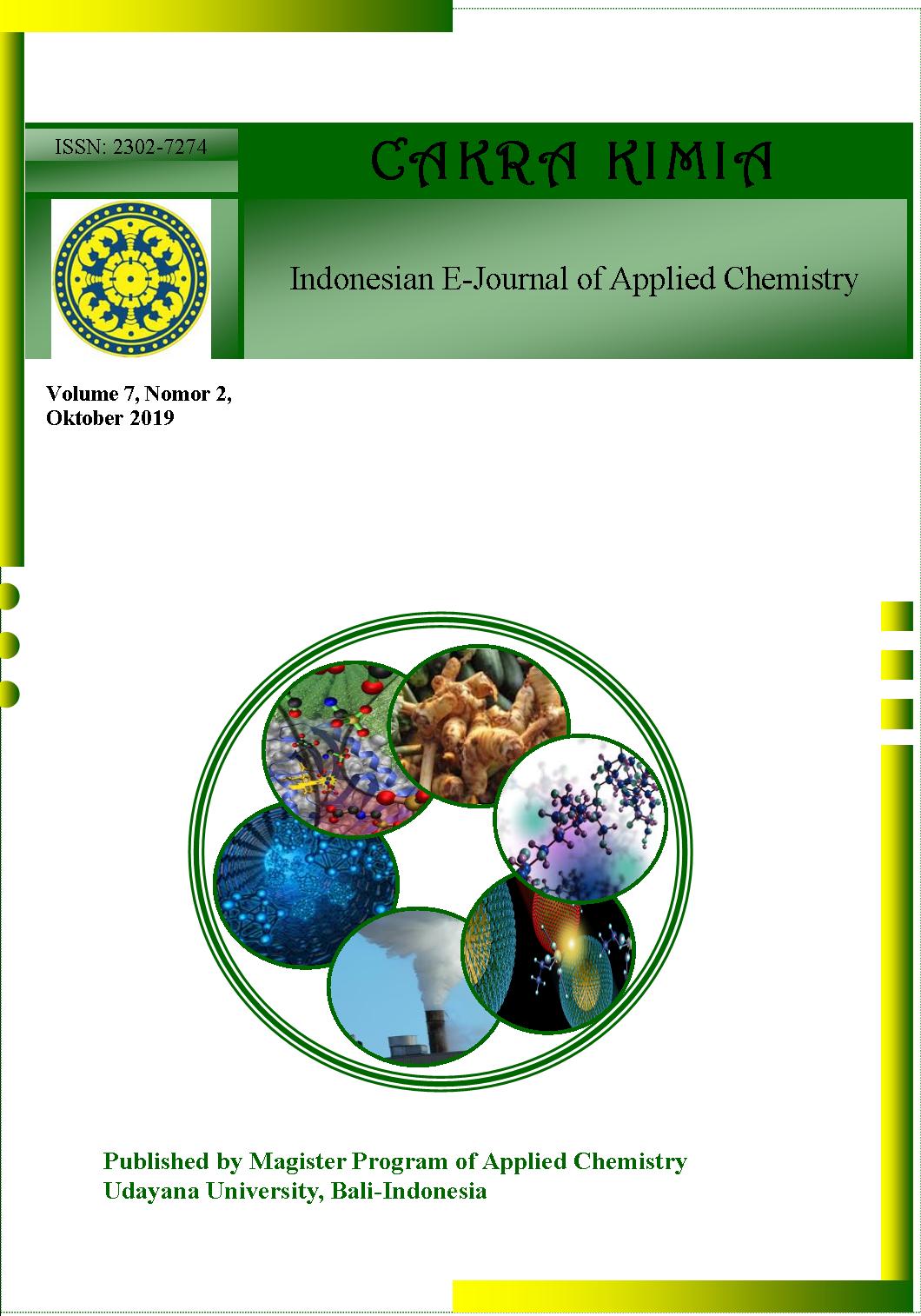SINTESIS NANOPARTIKEL PERAK (NPAg) MENGGUNAKAN EKSTRAK AIR DAUN KEMANGI (Ocimum Sanctum Linn.) DAN APLIKASINYA DALAM FOTODEGRADASI ZAT WARNA METILEN BIRU
Abstract
ABSTRAK: Penelitian ini bertujuan untuk mensintesis nanopartikel perak (NPAg) menggunakan ekstrak air daun kemangi (Ocimum Sanctum Linn.) yang digunakan sebagai katalis untuk fotodegradasi metilen biru. Ekstrak air daun kemangi mengandung senyawa flavonoid dan tanin yang berfungsi sebagai bioreduktor untuk mereduksi Ag+ menjadi Ag0 dan penstabil nanopartikel perak. Perbandingan volume ekstrak daun kemangi dengan volume larutan AgNO3 1 mM divariasikan sebesar 1:9, 2:8, 3:7, 4:6, 5:5 dan suhu sintesis juga divariasikan pada 25, 40, 50, 60. Keberhasilan sintesis dikonfirmasi dengan spektroskopi sinar tampak pada panjang gelombang 447 nm. Analisis nanopartikel perak (NPAg) dilakukan dengan Particle Size Analyser (PSA). Perbandingan volume optimum diperoleh pada perbandingan 2:8 dengan ukuran NPAg sebesar 70,190,89 nm. Degradasi metilen biru dilakukan pada kondisi optimum dimana volume nanopartikel sebesar 4 mL, pH 10 dan waktu fotodegradasi selama 3 jam. Fotodegradasi metilen biru pada kondisi optimum tersebut adalah sebesar 77,90% dari konsentrasi awal sebesar 200 ppm.
Kata Kunci: Nanopartikel perak, kemangi (Ocimum Sanctum Linn), fotodegradasi, metilen biru, bioreduktor.
ABSTRACK: Synthesis of silver nanoparticles (NPAg) used as catalysts for photodegradation of methylene blue was conducted using water extract of basil leaves (Ocimum Sanctum Linn.). The water extract of basil leaves contains flavonoids and tannins which function as bioreductors of Ag+ to Ago and stabilize silver nanoparticles. The volume ratio of basil leaf extract to solution of AgNO 3 1 mM were varied by 1: 9, 2: 8, 3: 7, 4: 6, 5: 5 and the synthesis temperature was also varied at 25 ?, 40 ?, 50 ?, 60 ?. The success of the synthesis was confirmed by visible light spectroscopy at a wavelength of 447 nm. Analysis of silver nanoparticles (NPAg) was carried out with the Particle Size Analyzer (PSA). The optimum volume ratio was obtained at a ratio of 2: 8 with the NPAg size of 70.19 ± 0.89 nm. The optimum conditions for photodegradation of methylene blue were achieved at nanoparticle volume of 4 mL, pH of 10, and irradiation time of 3 hours. The photodegradation of methylene blue at these optimum conditions was 77.90% out of 200 ppm of mentylene blue solution.
Downloads
References
[2] Wijaya, K., Sugiharto, E., Fatimah, I., Sudiono, S., Kurniaysih, D. 2006. Utilisasi TiO2- Zeolit dan Sinar UV untuk Fotodegradasi Zat Warna Cango Red. Berkala MIPA 3: 27-35.
[3] Haryani, Y., Kartika, F.G., Yuharmen, Putri, M.E., Alchalish, T.D., Melanie, Y. 2016. Pemanfaatan Ekstrak Air Rimpang Jahe Merah (Zingiber Officinale Linn Varrubrum) pada Biosintesis Sederhana Nanopartikel Perak. Chemica et Natura Acta 4(3): 151-155.
[4] Sharma, V.K., Yhgard, R.A., Lin, Y. 2009. Silver Nanoparticles: Green Synthesis and their antimicrobial activities. Advances in Colloid and Interface Science 145(9): 83-96.
[5] Tang, C. dan Chen, V. 2004. The Photocatalytic Degradation of Reactive Black 5 Using TiO2/UV in An Annular Photoreactor. Water Research 38: 2775-2781.
[6] Mallikarjuna, K., Narasimha, G., Dillip, G.R., Praveen, B., Shreedhar, B., Lakshmi, C.S., Reddy, B.V.S., Raju, B.D.P. 2011. Green Synthesis of Silver Nanoparticles Using Ocimum Leaf Extract and Their Characterization. Digest Journal of Nanomaterials and Biostructures 6(1): 181-186.
[7] Angelina, M., Turnip, M., Khotimah, S. 2015. Ujian Aktivitas Antibakteri Ekstrak Etanol Daun Kemangi(Ocimum Sanctum L.) Terhadap Pertumbuhan Bakteri Escherichia Coli dan Staphylococcus Aureus. Protobiont 4(1): 184-189.
[8] Michalak, A. 2006. Phenolic Compound and Their Antioxidant Activity in Plants Growing under Heavy Metal Stress. Polis Journal of Enviroumental Study 15(4): 523-530.
[9] Masakke, Y., Sulfikar, Rasyid, M. 2015. Biosintesis Partikel-nano Perak Menggunakan Ekstrak Metanol Daun Manggis (Garcinia Mangostana L.). Jurnal Sainsmat IV(1): 28-41.
[10] Awwad, M.A., Salem, M.N., Abdeen O.A. 2013. Green Synthesis of Silver Nanoparticles Using Carob Leaf Extract and Its Antibacterial Activity.
International Journal of Industrial Chemsitry 4: 1-6.
[11] Zakir, M., Maming, Lembang, Y.E., Lembang, S.M. 2014. Synthesis of Silver and Gold Nanoparticles Through Reduction of Ketapang (Terminalia Catappa). Presents in the International Conference on Advanced Material and Partical Nanotechnology: 1-9.
[12] Tapa, L.F., Suryanto, E., Momuat, I.L. 2016. Biosintesis Nanopartikel Perak Menggunakan Ekstrak Empelur Batang Sagu Baruk (Arenga Microcarpha) dan Aktivitas Antioksidannya. Chem.Prog 9(1): 9-15.
[13] Maryani, D., Firdaus, L.M., Nurhamidah. 2017. Biosintesis Nanopartikel Perak Menggunakan Ekstrak Buah Markisa (PassifbraFlavicarva) untuk Mendeteksi Logam Berat. Jurnal Pendidikan dan Ilmu Kimia 1(1): 49-54.
[14] Sopianti, S.D. dan Sary, W.D. 2018. Skrining Fitokimia dan Profil KLT Metabolit Sekunder dari Daun Ruku-ruku (Ocimum Tenolflorum L.) dan Daun Kemangi (Ocimum Sanctum L.). Scientia8(1): 44-52.
[15] Diantariani, P.N., Widihati, G.A.I., Megasari, R.A.A.G.I. 2014. FotodegradasiMetilen Biru dengan Sinar Ultarviolet dan Katalis ZnO. Jurnal Kimia 8(1): 137-143.
[16] Bar, H., Bhui, Kr.D., Sahoo, P.G., Sarkar, P., Pyne, S., Misra, A. 2009. Green Synthesis of Silver Nanoparticles Using Seed Extract of JatrophaCurcas. Colloids and Surfaces a Physicochemical and Engineering Aspects 348: 212-216.
[17] Solomon, S.D.M., Bahadory, A.V., Jeyarajasingam, S.A., Rutkowsky, C., Borits. 2007. Synthesis and Study of
Silver Nanoparticles. Journal of Chemical Education 84(2): 322-325
[18] Pinto, V.V., Ferreira, M.J., Silva, R., Santus, H.A., Silva, F., Pereira, C.M. 2010. Long Time Effect on the Stability of Silver Nanoparticles in Aqueous Medium: Effect of the Synthesis and Stronge Condition, Colloids Surf. A: Physicochem. Eng. Aspects 364: 19-25.
[19] Gunsolus, I.L., Mousavi, M.P.S., Hussein, K., Buhlmann, P., Haynes, C.L. 2015. Effect of Humic and Funic Acids on Silver Nanoparticles Stability, Dissolution and Toxicity. Environ Sci. Technol. 49: 8078-8086.
[20] Ayu, H. 2015. “Kinetika Sintesis Nanopartikel Perak dari Larutan AgNO3 dengan Menggunakan Ekstrak Bungkil Biji Jarak Pagar (JatrophaCuras L.) sebagai Reduktor” (Tesis). Bogor: Institut Pertanian Bogor.
[21] Attia, A.J., Kadhim, S.H., Hussen, F.H. 2007. Photocataliytc Degradation of Textile Dyeing Wastewater Using Titanium Dioxide and Zin Oxide. E-Journal of Chemistry 2: 219-223.



 Petunjuk Penulisan
Petunjuk Penulisan
